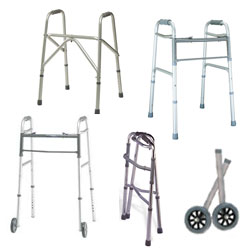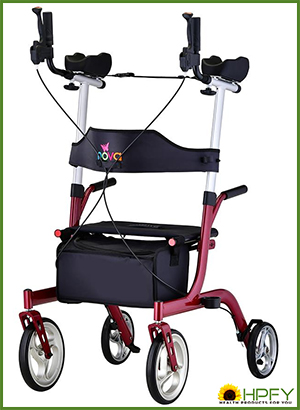Standard Mobility Walkers
Standard walkers are basic metal frames, usually aluminum, designed to provide stability and support for people with independent mobility issues. The standard mobility walker consists of a simple metal framework, with four adjustable legs that allow the walker to be set to the optimum height for the user. The top rail of the walker will have two hand grips which will be either a hard rubber or softer foam. The softer foam grips are easier and more comfortable to grip but will wear out with time. The foam walker hand grips are replaceable for a reasonable cost from most home health care vendors and many drug stores.
As with any other walker style, I feel the user should actually try the walker, or have previous experience with the style, they are purchasing for safety.
Height Adjustment
Setting the proper height for a walker is important for the comfort, safety and posture of the user. Generally the top of the walker's hand grips should be at the same height as the user's wrist where it meets the hand when the user is standing as upright as they can. The important thing is there should be a small bend in the user's elbow when using the walker.
How to Use a Standard Walker
Using the standard mobility walker is pretty straight forward. The user has the walker in front of them, steps into it from the rear, lifts the walker forward about a foot (depending on reach and stability of the user)and steps into it again. To turn a corner or change directions the user lifts the walker in the direction they want go and steps into again.
The standard mobility walker is not intended to take all of the weight of he user but some weight can be transferred off the legs when stepping forward. Using a standard mobility walker is not fast, nor is it intended to be. Using standard mobility walker is more about balance and stability while walking rather than it is about speed. In order to use this type of walker, or any walker for that matter, the user must have some control of their balance, enough strength in their legs to support their own weight and some strength in their arms and hands.
Folding Standard Walkers
Although the original standard mobility walkers did not fold, many manufacturers modified the design to allow folding for easier transporting and storage. Today, almost all standard walkers fold with simply the pushing of one or two small buttons to collapse the walker. Because these models fold they have a few more parts and tend to be a little heavier but not noticeably so.
The one thing that one has to be careful of with folding standard walkers is that after several years of regular use the mechanism that allows the walker to fold will become worn and the walker may become a little wobbly. Sometimes they can be tightened up but often the only solution is to replace them with a new walker. These walkers are not very expensive and usually the cost of replacing them is not too bad.
Wheel Attachments
Another addition manufacturers made to the standard walker was wheel attachments. They are usually sold in pairs and can be purchased with the walker or after the fact. Wheeled walkers require a little more care in use as they move easier and if not careful the user may find them moving too easily.
There are three types of wheel attachments for standard walkers:
- Fixed front wheels - Fixed front wheel walkers do not have to be completely lifted off the ground to be pushed forward. The user only has to lift the back of the walker, push forward and step into it. The walker still needs to be lifted to change directions.
- Swivel front wheels - Swivel front wheeled walkers make it easier to go forward and turn corners. The walker does not have to be lifted at the front to change direction.
- Auto-stop rear wheels - Auto-stop rear wheel attachments are always to be used with either fixed or swivel front wheeled walkers. The user does not have to lift the walker at all when walking, they push forward and step into it. When the user puts their weight on the walker, the auto-stop wheels do not roll so the walker is more stable.
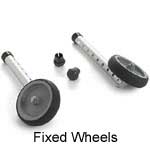
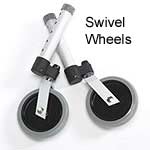
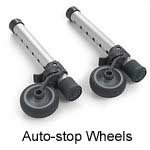
Walker Bags, Baskets & Trays
Using a walker generally requires the use of both hands however often people want to be able to carry a book, purse, newspaper or other items with them when walking. Some after market companies have designed bags, baskets and trays for this purpose and they are available at many drug stores and home health care stores.
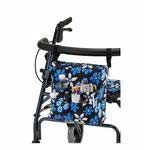
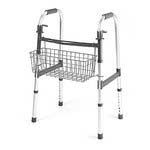
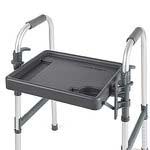
Some care must be used when choosing a walker bag, basket or tray because when they have weight in them, they could throw the balance of the walker off making it unstable. Another issue is, if the walker does not have wheels, the user will have to lift the weight of the walker as well as what they are carrying. Trays are particularly precarious because people tend to carry drinks and meals on them that can spill if the walkers hits a bump or obstacle during use.


 Online Vendors
Online Vendors  US Online Vendors
US Online Vendors 